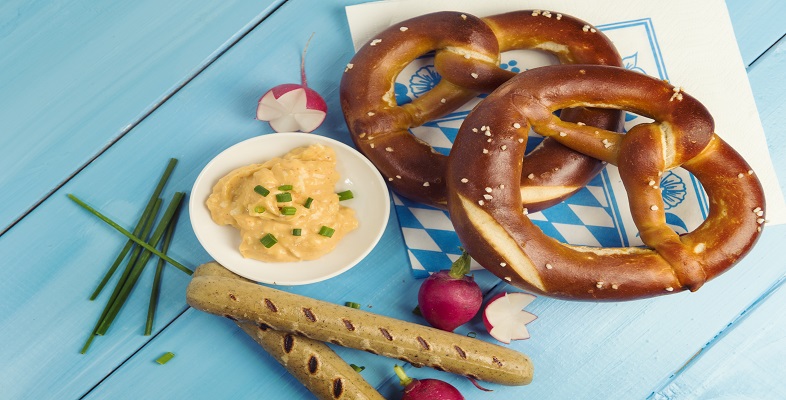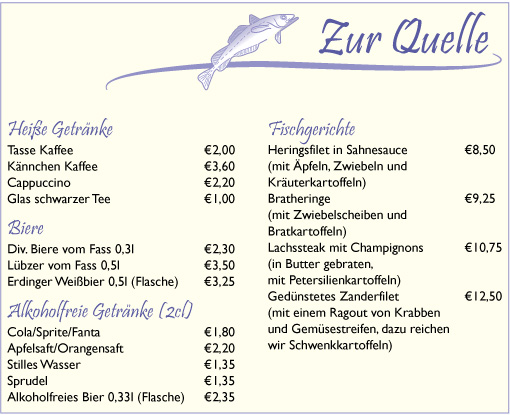5 Placing an order
Activity 16
When visiting friends or colleagues in Germany, you will normally be offered something to drink. In this audio clip, you will hear people offering a number of things to drink. Practice your responses out loud. It is up to you to choose whether to accept (ja, bitte) or decline (nein, danke) based on your preferences, so there are no right or wrong answers to this activity.
Beispiel
You hear: Möchten Sie eine Tasse Kaffee?
You say: Ja, bitte. / Nein, danke.
Transcript: Audio 12
Hören Sie und sprechen Sie.
Möchten Sie eine Tasse Kaffee?
➜
Möchten Sie einen Tee mit Zitrone?
➜
Möchten Sie einen Orangensaft?
➜
Möchten Sie ein Glas Bier?
➜
Möchten Sie eine Cola?
➜
Möchten Sie ein Glas Milch?
➜
Möchten Sie einen Schnaps?
➜
Language: Speaking politely
When you are offered something you tend to say more than just ja and nein, for example ‘yes, please’ (ja, bitte) or ‘no, thank you’ (nein, danke). Danke on its own in this context is usually understood to mean nein, danke.
In the audio clip in Activity 15 you may have noticed that the waitress used bitte schön in two different ways. First she used the phrase as a question: Bitte schön? meaning ‘Yes, please?’ to ask what the customers wanted. Later she said Bitte schön meaning ‘Here you are’ as she served the items.
There is a third situation where Bitte schön commonly occurs: in response to Danke schön it means ‘Don’t mention it’ or ‘You’re welcome’. Listen out for these three uses of Bitte schön and take particular note of the intonation used in each case.
- Vokabeln
- die Speisekarte menu
- die Kellnerin waitress
Activity 17
Here is a written extract from a café conversation with a few key words missing. Use some of the language you have just learned to fill in the gaps. You can note your answers in the box beneath the text.
In the previous activity you might have noticed the change of the indefinite article ein to einen. This is an indication of the use of the accusative case with masculine nouns that functions as an object in a sentence. The same happens when the definite article der becomes den.
| Gast | Entschuldigung! Die Speisekarte, bitte! |
| Kellnerin | Ja, sofort. … Bitte _________. |
| (später) | |
| Kellnerin | Möchten _________ bestellen? |
| Gast | Ja, ich _________ einen Kaffee, bitte. |
| Kellnerin | Eine Tasse oder ein _________? |
| Gast | Eine Tasse, bitte. |
| Kellnerin | Sonst noch _________? |
| Gast | Nein, danke. |
Note: make sure you use capital letters in the right places.
Answer
| Gast | Entschuldigung! Die Speisekarte, bitte! |
| Kellnerin | Ja, sofort. … Bitte schön. |
| (später) | |
| Kellnerin | Möchten Sie bestellen? |
| Gast | Ja, ich möchte einen Kaffee, bitte. |
| Kellnerin | Eine Tasse oder ein Kännchen? |
| Gast | Eine Tasse, bitte. |
| Kellnerin | Sonst noch etwas? |
| Gast | Nein, danke. |
Activity 18
Now it’s your turn to play the customer’s part, using the script put together in the previous activity. You may want to refer to the audio transcript below to guide you, or just to help recall some of the phrases. You will start the dialogue by calling for the menu.
Beispiel
You say: Entschuldigung! Die Speisekarte, bitte.
You hear: Entschuldigung! Die Speisekarte, bitte.
Transcript: Audio 13
Hören Sie und sprechen Sie. Bitte beginnen Sie jetzt.
Activity 19
Here is a menu from a specialist fish restaurant. Read this menu, which will be used in the second part of this activity. You don’t need to understand every word but try to get a rough idea of what the items mean.
Now listen to the audio clip below, and practise ordering a main course by following the whispered prompts you hear. You will start by calling (rufen) the waitress.
Beispiel
You hear: Rufen Sie die Kellnerin.
You say: Entschuldigung!
You hear: Entschuldigung!
Transcript: Audio 14
Bitte hören Sie und sprechen Sie.
(Rufen Sie die Kellnerin.)

